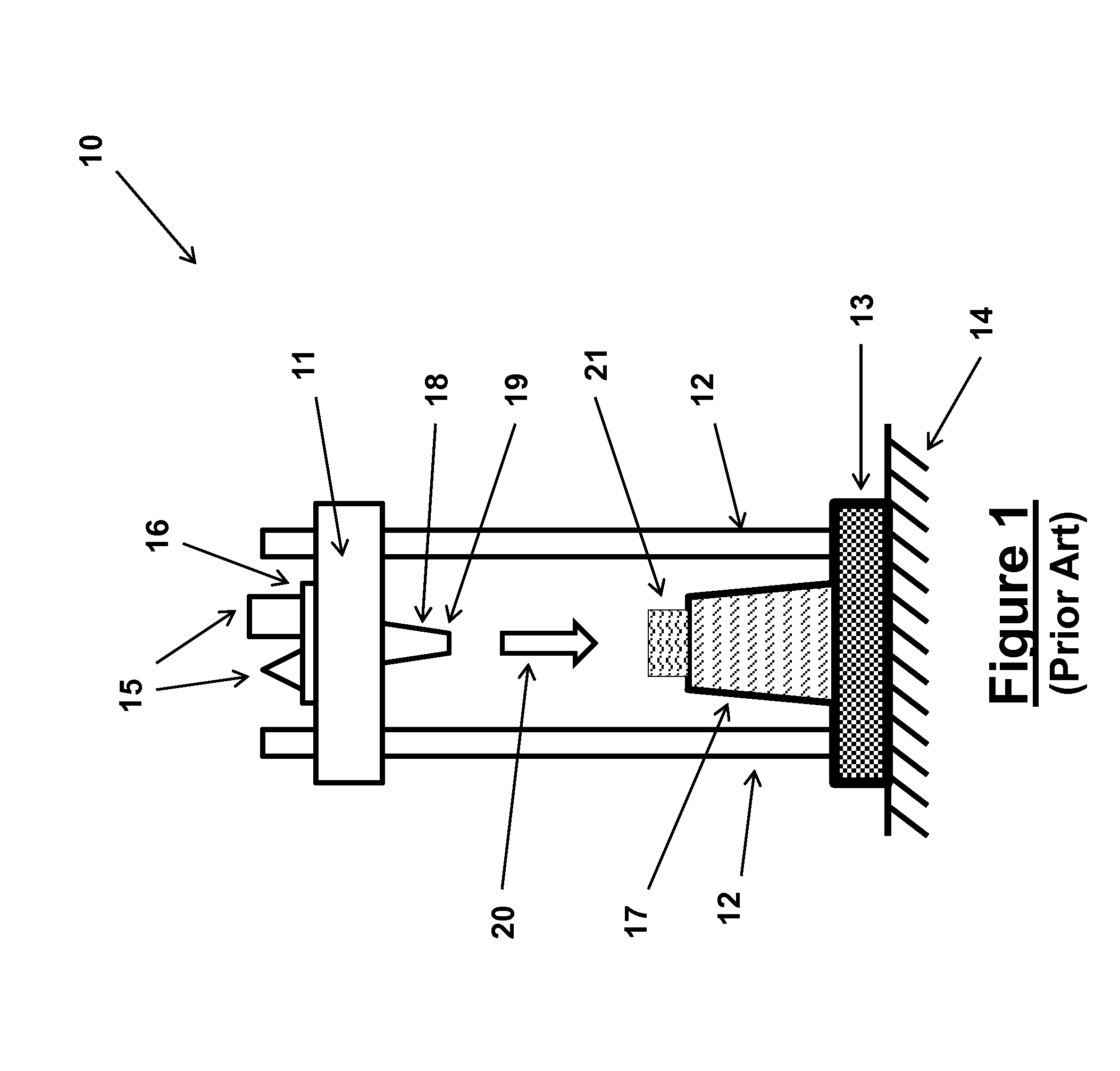Mechanical High-G Shock Testing Machines
- Summary
- Abstract
- Description
- Claims
- Application Information
AI Technical Summary
Benefits of technology
Problems solved by technology
Method used
Image
Examples
embodiment 30
[0084]A schematic of a first mechanical shock testing machine embodiment 30 is shown in FIG. 2. The basic structure of the mechanical shock testing machine 30 is the same as the shock testing machine 10 of the prior art shown in the schematic of FIG. 1. The schematic of FIG. 2 is intended to show only the main components of the present mechanical shock testing machine 30. The mechanical shock machine 30 is similarly constructed with some type of rails 22 along which the impact mass element 23 travels. The rails (one or more) may have any cross-sectional shape and the sliding surfaces between the mass element 23 and the rails 22 may be covered with low friction material or may utilize rolling elements to minimize sliding friction. The rails 22 are generally mounted on a relatively solid and massive base 24, which in turns rests on a firm foundation 25. Certain relatively stiff shock absorbing elements (not shown) may be provided between the base 24 and the ground 25 to prevent damage...
embodiment 50
[0102]In the mechanical shock testing embodiment 50, the braking elements 51 are initially applying no braking force to the rails 22, i.e., the brake pads (similar to the pads 37 shown in FIG. 4) are not pressed against the surface of the rails 22. This would therefore allow the assembly of the mass element 52 and braking elements 51 to be accelerated downwards (under gravity for vertically installed shock testing machines and / or pre-tensioned bungee cords or pneumatic cylinders or other similar means as was previously described) to gain a predetermined velocity. Then once the mass element and braking element assembly has gained the predetermined velocity, the braking elements 51 are engaged and begin to apply a prescribed level of braking force to the rails 22, thereby causing the mass element 52 to be decelerated at the desired rate, thereby subjecting the testing components 53 to a predetermined and essentially constant deceleration (shock) pulse that lasts until the assembly of ...
embodiment 29
[0107]As can be seen in the schematic of FIG. 6, the relatively thin (flexible) strap 55 (element 39 in the embodiment 29 of FIG. 4) which is made out of high strength material (such as spring steel) is provided with extended ends 56. A spacing element 57 is positioned between the extended ends 56. A pair of bolt 58 and nut 59 is passed through provided holes (not shown) in the extended ends 56, and is used to preload the compressive spring 60. The spacing element 57 can be provided with a slight wedging angle to make it easier to be pulled out from between the extended ends 56 in the direction of the arrow 62 by the cable 61. Once the spacing element 57 has been pulled out, the preloaded compressive spring 60 would apply a force to the extended ends 56 that tends to bring them together, thereby applying a compressive force to the brake pads 37, thereby generating the desired braking force between the braking elements 51 and the rails 22 to begin to decelerate the mass element 52 an...
PUM
 Login to View More
Login to View More Abstract
Description
Claims
Application Information
 Login to View More
Login to View More - R&D
- Intellectual Property
- Life Sciences
- Materials
- Tech Scout
- Unparalleled Data Quality
- Higher Quality Content
- 60% Fewer Hallucinations
Browse by: Latest US Patents, China's latest patents, Technical Efficacy Thesaurus, Application Domain, Technology Topic, Popular Technical Reports.
© 2025 PatSnap. All rights reserved.Legal|Privacy policy|Modern Slavery Act Transparency Statement|Sitemap|About US| Contact US: help@patsnap.com



